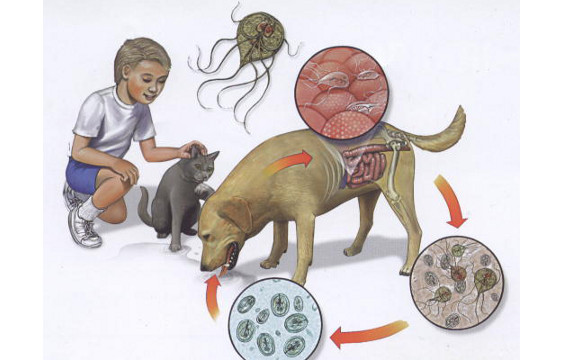Giardia lamblia is a microscopic parasite that causes giardiasis in cats. This guide covers everything you need to know about Giardia, including transmission, symptoms, diagnosis, treatment, and prevention.
What is Giardia?
Giardia lamblia is a single-celled organism that inhabits the small intestines of cats. It exists in two forms: a motile trophozoite and a hardy cyst. The cysts, which are excreted in feces, can survive harsh environmental conditions, making them the primary means of transmission.
How is Giardia Transmitted?
Giardia cysts are shed in the feces of infected cats and can be ingested by other cats through contaminated water, food, or surfaces. The infection rate in North America is relatively low (about 4%), but it can cause outbreaks in environments where many cats live together, such as catteries, shelters, and multi-cat households.
Symptoms of Giardiasis
The primary symptom of giardiasis is diarrhea, which can be sudden or chronic. Other symptoms include:
- Blood or mucus in stools
- Weight loss
- Lethargy
- Poor grooming
Since these symptoms can indicate other health issues, a veterinarian’s diagnosis is crucial.
Diagnosis of Giardia
Giardia cysts are identified through fecal smear examinations under a microscope. Because cysts are shed intermittently, multiple samples may be required for an accurate diagnosis. Special staining techniques can help in identifying the parasite.
Treatment of Giardiasis
Giardiasis is commonly treated with metronidazole (Flagyl) or other oral medications. Cats often show resistance to treatment, requiring multiple courses or different medications. Maintaining hygiene by regularly cleaning and disinfecting litter boxes can prevent the spread of Giardia.
Can Giardia Spread to Humans?
While there is a human form of giardiasis, the strains that infect cats may not always affect humans. However, good sanitation practices, such as washing hands after handling litter boxes, are recommended to reduce the risk of transmission.
Detailed Insights and Preventative Measures
Environmental Management
Preventing giardiasis involves meticulous cleaning of the cat’s environment. Use a 30:1 solution of chlorine bleach to disinfect litter boxes and consider steam cleaning surfaces where cysts might be present. Regularly changing and washing bedding, toys, and feeding dishes can also help reduce the risk of infection.
Immune System Factors
Cats with weakened immune systems, such as those with FIV or FeLV, are more susceptible to giardiasis. Ensuring that your cat receives regular veterinary check-ups and vaccinations can help maintain their overall health and reduce the likelihood of severe giardiasis.
Hydration and Nutrition
Proper hydration and a balanced diet play a crucial role in managing and preventing giardiasis. Ensure that your cat has access to clean, fresh water at all times. Avoid letting your cat drink from potentially contaminated sources such as streams or ponds.
Hygiene Practices for Owners
To minimize the risk of zoonotic transmission, practice good hygiene. Wash your hands thoroughly with soap and water after cleaning litter boxes and before preparing food. Disinfect surfaces and wash any clothing or materials that might have come into contact with infected feces.
Advanced Diagnostic Techniques
For persistent or severe cases, veterinarians may use advanced diagnostic tools such as ELISA tests or PCR assays to detect Giardia antigens in the feces. These methods can offer more accurate results than traditional microscopic examination.
The Lifecycle of Giardia
Understanding the lifecycle of Giardia can aid in its management. The parasite’s lifecycle includes:
- Ingestion of cysts by the host.
- Cysts transform into trophozoites in the small intestine.
- Trophozoites multiply and may cause symptoms.
- Some trophozoites form cysts, which are then excreted in the feces.
Breaking this cycle through environmental control and treatment is key to managing giardiasis.
Case Studies and Real-life Examples
Several case studies have shown that early intervention and strict hygiene practices can effectively control giardiasis outbreaks in multi-cat environments. In one instance, a shelter implemented a rigorous cleaning schedule and isolation protocols for infected cats, resulting in a significant decrease in new cases.
Future Directions and Research
Ongoing research aims to develop more effective treatments and vaccines for giardiasis. New medications and potential immunotherapies are being tested to improve outcomes for infected cats. Staying informed about these advancements can help cat owners and veterinarians better manage and prevent this parasitic infection.
Conclusion
Giardia lamblia poses a significant health risk to cats, especially in multi-cat environments. Understanding its transmission, symptoms, diagnosis, and treatment can help manage and prevent outbreaks. Maintaining proper hygiene, monitoring the cat’s health, and consulting with a veterinarian for appropriate treatment are essential steps in keeping your cat healthy and free from giardiasis.
For more detailed information, you can visit the original article here.

